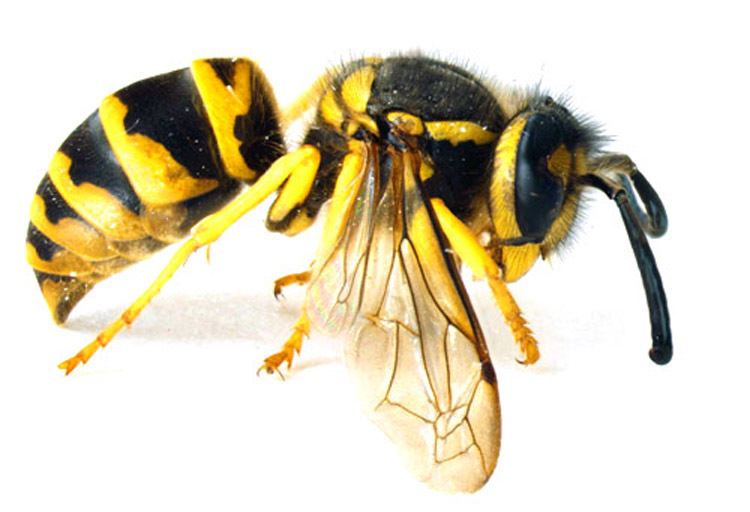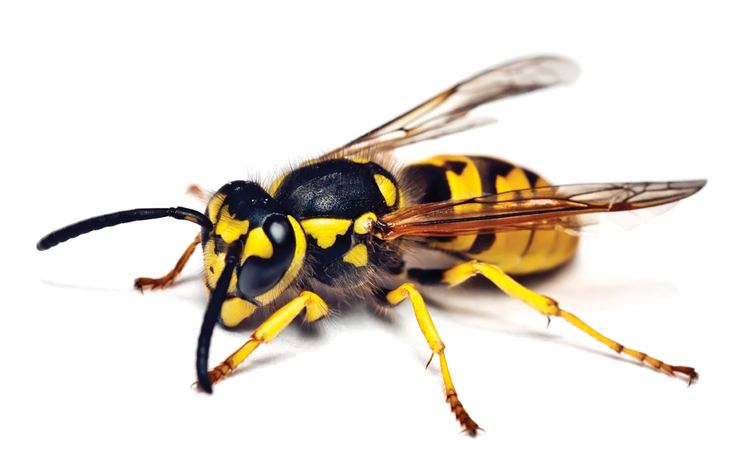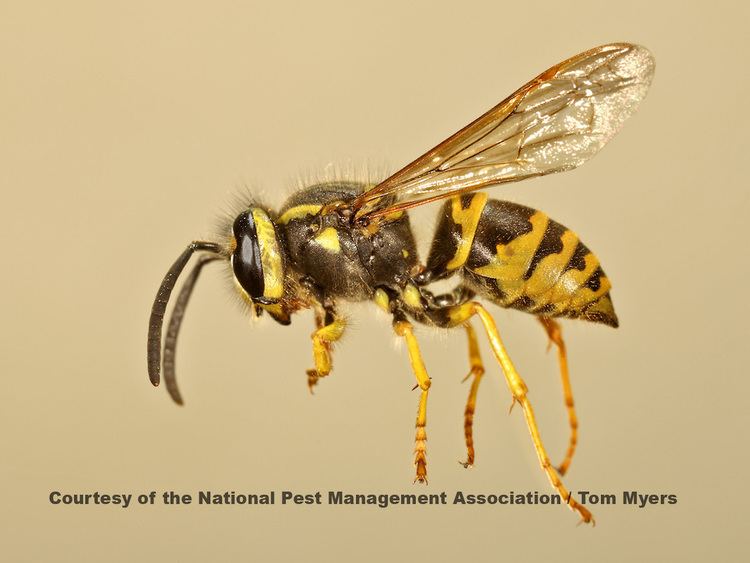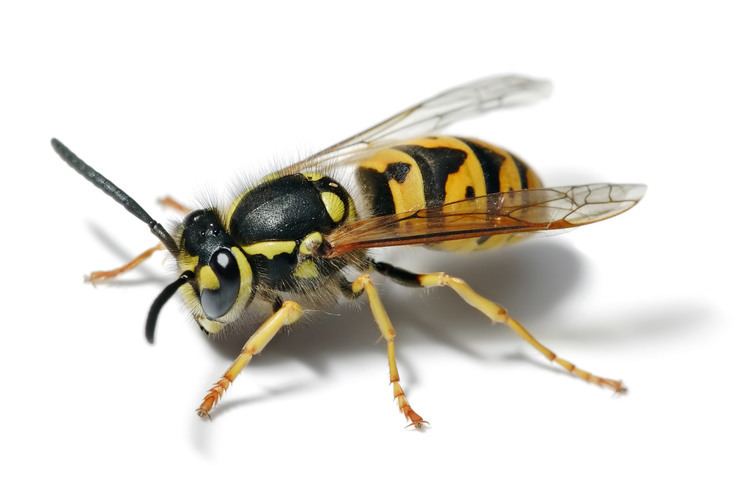 | ||
Representative species Bald‑faced hornet, Vespula germanica, Common wasp, Eastern yellowjacket, Vespula pensylvanica | ||
Yellowjackets
Yellowjacket is the common name in North America for predatory wasps of the genera Vespula and Dolichovespula. Members of these genera are known simply as "wasps" in other English-speaking countries. Most of these are black and yellow like the eastern yellowjacket Vespula maculifrons and the Saxon wasp Dolichovespula saxonica; some are black and white like the bald-faced hornet, Dolichovespula maculata. Others may have the abdomen background color red instead of black. They can be identified by their distinctive markings, their occurrence only in colonies, and a characteristic, rapid, side-to-side flight pattern prior to landing. All females are capable of stinging. Yellowjackets are important predators of pest insects.
Contents
- Yellowjackets
- Identification
- Life cycle and habits
- Notable species
- Nest
- In the United States
- In popular culture
- References

Identification

Yellowjackets are sometimes mistakenly called "bees" (as in "meat bees"), given that they are similar in size and appearance and both sting, but yellowjackets are actually wasps. They may be confused with other wasps, such as hornets and paper wasps. Polistes dominula, a species of paper wasp, is very frequently misidentified as a yellowjacket. A typical yellowjacket worker is about 12 mm (0.5 in) long, with alternating bands on the abdomen; the queen is larger, about 19 mm (0.75 in) long (the different patterns on their abdomens help separate various species). Workers are sometimes confused with honey bees, especially when flying in and out of their nests. Yellowjackets, in contrast to honey bees, are not covered with tan-brown dense hair on their bodies, they do not carry pollen, and do not have the flattened hairy hind legs used to carry it.

These species have lance-like stingers with small barbs, and typically sting repeatedly, though occasionally a stinger becomes lodged and pulls free of the wasp's body; the venom, like most bee and wasp venoms, is primarily only dangerous to humans who are allergic or are stung many times. All species have yellow or white on their faces. Their mouthparts are well-developed with strong mandibles for capturing and chewing insects, with probosces for sucking nectar, fruit, and other juices. Yellowjackets build nests in trees, shrubs, or in protected places such as inside man-made structures, or in soil cavities, tree stumps, mouse burrows, etc. They build them from wood fiber they chew into a paper-like pulp. Many other insects exhibit protective mimicry of aggressive, stinging yellowjackets; in addition to numerous bees and wasps (Müllerian mimicry), the list includes some flies, moths, and beetles (Batesian mimicry).

Yellowjackets' closest relatives, the hornets, closely resemble them, but have larger heads, seen especially in the large distance from the eyes to the back of the head.
Life cycle and habits
Yellowjackets are social hunters living in colonies containing workers, queens, and males (drones). Colonies are annual with only inseminated queens overwintering. Fertilized queens are found in protected places such as in hollow logs, in stumps, under bark, in leaf litter, in soil cavities, and man-made structures. Queens emerge during the warm days of late spring or early summer, select a nest site, and build a small paper nest in which they lay eggs. After eggs hatch from the 30 to 50 brood cells, the queen feeds the young larvae for about 18 to 20 days. Larvae pupate, then emerge later as small, infertile females called workers. Workers in the colony take over caring for the larvae, feeding them with chewed up meat or fruit. By midsummer, the first adult workers emerge and assume the tasks of nest expansion, foraging for food, care of the queen and larvae, and colony defense.
From this time until her death in the autumn, the queen remains inside the nest, laying eggs. The colony then expands rapidly, reaching a maximum size of 4000 to 5000 workers and a nest of 10,000 to 15,000 cells in late summer. (This is true of most species in most areas; however, Vespula squamata, in the southern part of its range, may build much larger perennial colonies populated by scores of queens, tens of thousands of workers, and hundreds of thousands of cells.) At peak size, reproductive cells are built with new males and queens produced. Adult reproductives remain in the nest fed by the workers. New queens build up fat reserves to overwinter. Adult reproductives leave the parent colony to mate. After mating, males quickly die, while fertilized queens seek protected places to overwinter. Parent colony workers dwindle, usually leaving the nest to die, as does the foundress queen. Abandoned nests rapidly decompose and disintegrate during the winter. They can persist as long as they are kept dry, but are rarely used again. In the spring, the cycle is repeated; weather in the spring is the most important factor in colony establishment.
The diet of the adult yellowjacket consists primarily of items rich in sugars and carbohydrates, such as fruits, flower nectar, and tree sap. Larvae feed on proteins derived from insects, meats, and fish, which are collected by the adults, which chew and condition them before feeding them to the larvae. Many of the insects collected by the adults are considered pest species, making the yellowjacket beneficial to agriculture. Larvae, in return, secrete a sugar material to be eaten by the adults; this exchange is a form of trophallaxis. In late summer, foraging workers pursue other food sources from meats to ripe fruits, or scavenge human garbage, sodas, picnics, etc., as additional sugar is needed to foster the next generation's queens.
Notable species
Nest
Dolichovespula species such as the aerial yellowjacket, D. arenaria, and the bald-faced hornet, tend to create exposed aerial nests. This feature is shared with some true hornets, which has led to some naming confusion.
Vespula species, in contrast, build concealed nests, usually underground.
Yellowjacket nests usually last for only one season, dying off in winter. The nest is started by a single queen, called the "foundress". Typically, a nest can reach the size of a basketball by the end of a season. In parts of Australia, New Zealand, the Pacific Islands, and southwestern coastal areas of the United States, the winters are mild enough to allow nest overwintering. Nests that survive multiple seasons become massive and often possess multiple egg-laying queens.
In the United States
In 1975, the German yellow jacket (V. germanica) first appeared in Ohio, and has now become the dominant species over the eastern yellowjacket. It is bold and aggressive, and can sting repeatedly and painfully if provoked. It will mark aggressors, and will pursue them if agitated. It is often confused with Polistes dominula, an invasive species in the United States, due to their very similar pattern. The German yellowjacket builds its nests in cavities—not necessarily underground—with the peak worker population in temperate areas between 1000 and 3000 individuals between May and August. Each colony produces several thousand new reproductives after this point through November. The eastern yellowjacket builds its nests underground, also with the peak worker population between 1000 and 3000 individuals, similar to the German yellowjacket. Nests are built entirely of wood fiber and are completely enclosed except for a small entrance at the bottom. The color of the paper is highly dependent on the source of the wood fibers used. The nests contain multiple, horizontal tiers of combs within. Larvae hang within the combs.
In the southeastern United States, where southern yellowjacket (Vespula squamosa) nests may persist through the winter, colony sizes of this species may reach 100,000 adult wasps. The same kind of nest expansion has occurred in Hawaii with the invasive western yellowjacket (V. pensylvanica).
In popular culture
The yellowjacket's most visible place in American popular culture is as a mascot, most famously with the Georgia Tech Yellow Jackets, represented by the mascot Buzz. Other college and university examples include the American International College, Baldwin-Wallace University, Black Hills State University, Cedarville University, Defiance College, Graceland University, Howard Payne University, LeTourneau University, Montana State University Billings, Randolph-Macon College, University of Rochester, University of Wisconsin–Superior, West Virginia State University, and Waynesburg University.
Note that yellowjacket is often spelled as two words (yellow jacket) in popular culture and even in some dictionaries. The proper entomological spelling, according to the Entomological Society of America, is as a single word (yellowjacket).
